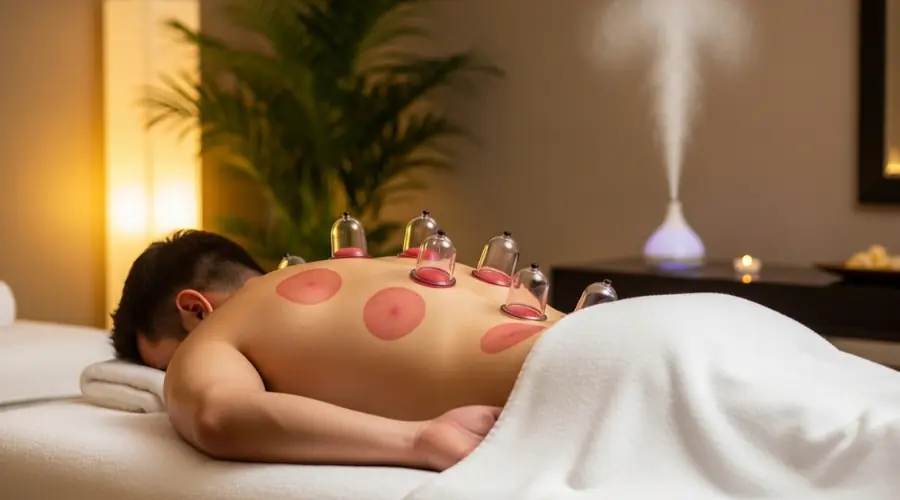You’ve probably noticed those circular marks, most commonly known as cupping marks or ecchymosis, on the backs of athletes and celebrities. Those distinctive circular marks are a common after-effect of cupping therapy, an ancient healing practice that’s still widely used today. But what exactly is it, and does it really work?
Cupping therapy might seem like a modern wellness trend, but it’s actually been around for thousands of years. With roots in ancient Egyptian, Chinese, and Middle Eastern medicine, this traditional healing method is still going strong today. In this article, we’re focusing on dry cupping, a non-invasive technique that creates suction on the skin to potentially ease muscle soreness and support recovery, without any cutting or bleeding involved.
While cupping continues to grow in popularity, it’s important to view it as a supportive therapy, not a standalone treatment. It may offer some benefits, especially for pain and muscle tension, but it should be used alongside standard medical care. In the sections ahead, we’ll look at the science behind cupping, what it might help with, and key safety considerations.
How Does Dry Cupping Work? The Potential Mechanisms
Dry cupping works by creating suction on the skin. During a session, a therapist places cups on specific areas of the body and removes the air inside, either with a hand pump or by briefly heating the cup. This creates a vacuum that gently pulls the skin and some of the tissue underneath into the cup. The idea is to increase blood flow to the area and help the body’s natural healing process. This action is thought to work through several potential mechanisms:
- Increased Local Blood Flow: The suction gently pulls on tiny blood vessels (capillaries), causing them to expand. This brings a surge of fresh, oxygenated blood to the area, which can promote healing.
- Cellular Repair & Inflammation Reduction: The localized "micro-trauma" from the suction may trigger an inflammatory response, stimulating the body's natural healing processes and the release of anti-inflammatory chemicals.
-
Muscle Tension Relief: The cupping lift decompresses and stretches tight fascia to relieve spasms. This method is often combined with complementary techniques like Dry Needling to address deeper muscle knots.
- Lymphatic Drainage: The suction may help stimulate the lymphatic system, which is responsible for clearing metabolic waste and toxins from your tissues.
- Pain-Gate Theory: Some researchers think that the feeling from cupping may block pain signals from reaching the brain, essentially “closing the gate” on how we perceive pain.
Potential Benefits of Dry Cupping

While more high-quality research is needed, existing studies and anecdotal evidence suggest several potential benefits:
- Pain Relief: This is the most common reason people turn to cupping, and it has shown potential for easing chronic neck pain and back pain, knee osteoarthritis and shoulder pain.
- Reduced Muscle Soreness and Tension: By increasing blood flow and loosening muscle fibers, cupping can help alleviate muscle stiffness and soreness, making it popular among athletes for recovery.
- Improved Blood Circulation: Enhanced blood flow means more oxygen and nutrients are delivered to tissues, which is vital for overall health and healing.
- Increased Range of Motion: For those with joint stiffness or conditions like frozen shoulder, cupping can help improve flexibility and movement.
- Support for Respiratory Health: Traditionally, cupping has been used on the back to help clear lung congestion and ease symptoms of asthma and bronchitis.
- Skin Health: Increased circulation may help manage certain skin conditions like acne by reducing inflammation and promoting healing.
- Relaxation and Stress Reduction: Similar to a deep-tissue massage, the experience of cupping can be deeply relaxing, helping to lower stress levels.
- Other Potential Uses: Preliminary research suggests cupping may also help with conditions like headaches, carpal tunnel syndrome, and high blood pressure, but much more research is required to confirm these effects.
The Scientific Evidence: A Balanced View
While some research points to possible benefits, the science behind cupping is still developing. Most of the studies we have are either small or not strong enough to draw firm conclusions.
- The Need for More Research: The scientific community widely agrees that more rigorous, large-scale clinical trials are needed to draw firm conclusions.
- The Placebo Effect: It's often suggested that cupping might work mainly because of the placebo effect, that people improve simply because they think the treatment will help. However, some studies have shown results that appear to go beyond that.
- A Complementary Approach: Until more definitive evidence is available, cupping should be considered a complementary therapy to be used in conjunction with proven medical treatments, not as a standalone cure.
Safety and Potential Side Effects

When performed by a trained and certified professional, dry cupping is generally considered safe. However, there are expected side effects and potential risks.
Common Side Effects:
- Circular Marks/Bruising: These circular marks are the most common side effect. They form as blood rises to the surface, but are typically painless and fade on their own within a few days to two weeks.
- Mild Discomfort: You may feel some tightness or soreness in the treated area.
- Skin Redness or Irritation.
- In rare cases: Mild fatigue, headache, or nausea immediately after a session.
Rare but More Serious Risks:
- Burns: This particular risk applies only to traditional fire cupping and isn’t an issue with modern pump-style cups.
- Skin Infection: Possible if hygiene standards are poor or if cupping is done over broken skin.
- Fainting (Vasovagal Syncope): Some people may feel lightheaded or faint during the procedure.
Who Should AVOID Cupping?
(Contraindications) Cupping is not safe for everyone. You should avoid it if you have any of the following conditions:
- Pregnancy
- A bleeding disorder (like hemophilia) or are taking blood-thinning medication
- A pacemaker or cardiovascular disease
- A history of seizures
- Anemia
- Skin conditions like psoriasis, eczema, sunburn, or an open wound
- Cancer or an organ-related disease
Choosing a Practitioner and Final Considerations

If you decide to try dry cupping, choosing the right provider is essential.
- Qualified Professionals: Cupping is often performed by licensed acupuncturists, physiotherapists, chiropractors, and massage therapists.
- Check Credentials: When seeking cupping therapy, ensure that the practitioner is appropriately certified and has formal training in the technique. They should adhere to strict hygiene and infection control protocols, including proper sterilization or disposal of equipment. It is also advisable to inquire about their clinical experience and specific training background to ensure safe and competent care.
- At-Home Cupping: While kits are available for purchase, proceed with extreme caution. If you choose to try it, start with silicone or plastic cups (not glass/fire) and inform your doctor.
Conclusion: An Informed Decision
Dry cupping is a great ancient technique to facilitate blood flow and causes acute inflammation to speed up healing.
Dry cupping after manual therapy is a wonderful addition to physiotherapy treatments.
The key takeaway is to approach it with an informed perspective. It is not a miracle cure, but it can be a valuable part of a comprehensive wellness plan. Always consult with your doctor or a qualified healthcare provider before starting any new therapy
to ensure it is safe and appropriate for you.
To experience these benefits firsthandbook a Dry Cupping sessionwith our specialists in Dubai




